Lantana ( Lantana camara ) is renowned as an invasive weed in many warm climate Countries, but there are several Dwarf or low-growing varieties, such as this Lantana camara "Landmark Yellow" and the Blue Lantana montevidensis, that are very useful plants in the landscape and garden. This Yellow Lantana grows to less than 1 metre tall, and is hardy once established and relatively pest free. It has a long flowering season, and is suitable for all temperate and warmer climates. Photo is from a Sydney garden.
*****Please keep comments limited to 200 words maximum and 5 pics/photos *****
*****1 person = 1 comment only , no using multiple accounts , thankyou *****
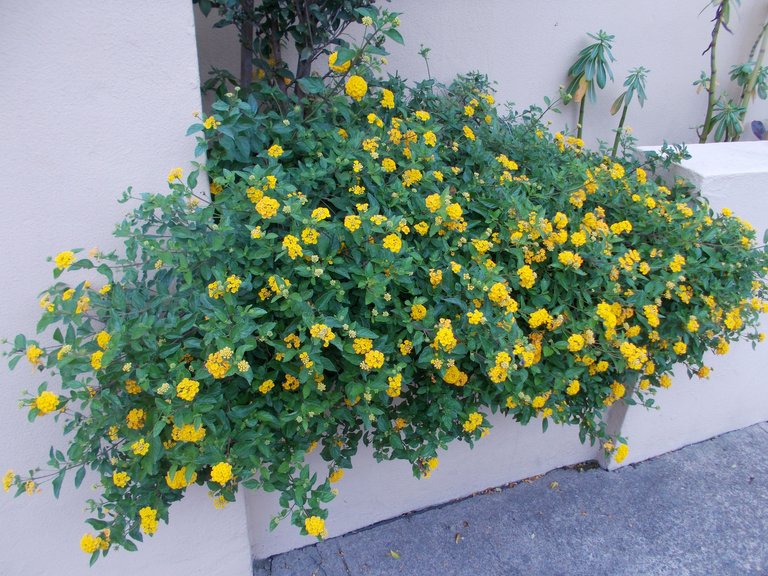
It was an early introduction elsewhere in the tropical world, where it soon escaped the confines of gardens and became a . L. camara is a prickly shrub, about 3-6 ft in height, with ovate rough leaves and almost continuous displays of blooms that appear as clusters made up of tiny florets. Orange or red-orange are the commonest colors, but there are cultivars with larger white, pink, or lemon-yellow flowers.
People like having Lantana in a garden because of the pungent smell of the leaves, and appreciate the reliable display of bright flowers. In Thailand, several colors are sometimes grafted onto a single trunk and the result trained into a standard. Lantana always prefers full sun and well-drained soil. Propagation is by air-layering or from woody cuttings.
SOURCE:
Congrats, you have won the Fav. comment Award for your comment .Great pics and short but informative info. Well done !
Congrats on being the fav comment! :)
Common lantana is a rugged evergreen shrub from the tropics. The species will grow to 6 ft (1.8 m) high and may spread to 8 ft (2.4 m) in width with some varieties able to clamber vinelike up supports to greater heights with the help of support.
The leaves are 2-5 in (5-12.7 cm) long by 1-2 in (2.5-5 cm) wide with rounded tooth edges and a textured surface. Stems and leaves are covered with rough hairs and emit an unpleasant aroma when crushed (smells like cat pee). The small flowers are held in clusters (called umbels) that are typically 1-2 in (2.5-5.1 cm) across. In the tropics lantana is a non-stop bloomer. Where it is killed to the ground by frost the lantana blooms in summer and fall.
Flower color ranges from white to yellow, orange to red, pink to rose in unlimited combinations, in addition the flowers usually change in color as they age. A lantana may look orange from a distance but the flowerhead is examined at close range it consists of individual white, yellow and red flowers that blend when viewed from afar.
Lantana is extremely easy to grow requiring little attention and is seldom bothered by pests or disease. It has low water requirements and can be used in xeriscapes and can handle the heat growing in containers and hanging baskets under sunny conditions. Lantana is a favorite species for butterflies and non-invasive lantanas should be a part of any butterfly garden.
Another lantana species that is also a popular garden plant is the weeping or trailing lantana Lantana montevidensis which is low growing trailing species that is particularly nice for hanging containers and groundcover.
Source
You have won the Silly Sausage Award for your comment and it's great pics and info. Well done !
Thank you! I will keep contributing to your posts. :)
The lantana plant is one of the most popular annuals used in gardens. They are favored because their blooms are long-lasting, they are easy to grow, and they thrive in most soil conditions. Deadheading is carried out to encourage continuous blooming and to prevent the growth of the berries. Some of the cultivated varieties (cultivars) of this plant grow to as much as 5 - 6 ft in height, forming large, bushy mounds, while others stay low and spread, reaching up to 4 ft in width, but only 1 - 2 ft in height.
Lantana is a genus consisting of more than 150 species of flowering plants in the Verbena family. The clusters of flowers borne by the lantana plants, called umbels, are a mix of red, orange, yellow, or blue and white florets. The flowers typically change color as they mature, resulting in a multicolored inflorescence. The flowers mature into toxic berries, which start off as green and turn black as they mature.
Growing and Caring for a Lantana
source
An insect repellent (also commonly called bug spray) is a substance applied to skin, Spanish Flag (Lantana camara) (against Tea Mosquito Bug.
Biologies, Coulidiati, Phytochemistry and biological activities of extracts of three 3 Species of Combretaceae of Burkina Faso: Combretum acutum Laws; Combretum nioroens Aubrex. Ex Keay and Combretum sericeum G. Balanitaceae used in traditional medicine in Burkina Faso.
Valensin Interaction of ferulic acid derivatives with human erythrocytes monitored by pulse field gradient NMR diffusion and NMR relaxation atudies. Chemistry and Physics of Lipids, Toxicology, Iseki, In vitro and in vivo antioxidant properties of ferulic acid: A comparative study with other natural oxidation inhibition.
In scrub areas of New Caledonia the plant scrambles through the vegetation not unlike climbers. However in taller forests it is absent and is rarely found in large treefall gaps. In areas where natural fires occur they stimulate thicker regrowth.
source of info
Lantana camara is a species of flowering plant in the verbena family, that is native to the American tropics. It has been introduced into other parts of the world as an ornamental plant and the Lantana camara ended to be considered an invasive species in many tropical and sub-tropical areas. It can be seen in the wild and along footpaths, deserted fields, and farms
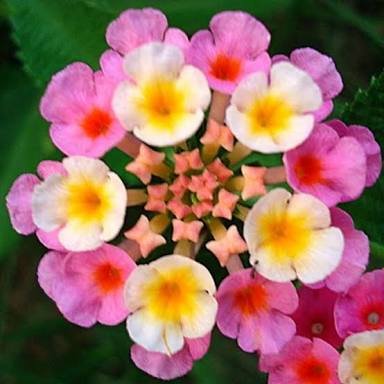.jpeg)

If you haven’t heard the news, the Lantana flower has grown up a lot and is no longer the fairly invasive, considered by some to be “a weed”, albeit a beautiful one, that it used to be. The careful cultivation of this semi-tropical plant that is native to the more tropical regions of Africa and the Americas has resulted in hybrids which have evolved to include those that can be potted
Lantanas like splendid and full sun, and flourish in any sort of soil which is a genuine in addition to for poor cultivating locales. You can skip waterings, yet when you do water, you will need to do as such completely. They have been known to wind up obtrusive in a few atmospheres, yet I genuinely can't picture it myself. In the event that they developed all the more completely in my garden, at that point I would love that. They emit such excellent little blooms that I simply cherish them, as do the butterflies. Lantanas draw in an extensive variety of butterflies.
Lantana is native to tropical regions of North and South American and Africa. Its berries are edible when ripe, but toxic while still green. The leaves are also toxic to animals and humans if ingested.
Lantana is a beautiful butterfly and hummingbird attracting plant. Chapel Hill Lantana is derived from a cross between Miss Huff and New Gold.
Lantana camara is a native to tropical regions and exists as dozens of strains and varieties that are highly variable in appearance. Although common lantana it is not native to Florida, it has been naturalized in the state for centuries (I wonder how many centuries it takes before a plant is considered native?)
Lantana is very easy to grow and will adapt to most soil types. Too much water and fertilizer will reduce bloom.By seed or cuttings taken in the summertime. Lantana hybrids and named selections are propagated by cuttings.
Lantana will add vibrant long-lasting color to shrub groupings. This is a fast growing shrub that is quick to flower so gardeners in cold climates can enjoy this tropical plant as an annual. Lantana tolerates salt spray and can be used in beach plantings.
Pets have reportedly become ill after ingesting lantana. The unripe berries are known to be very toxic and the foliage toxic to livestock. Lantana is listed as a Category I invasive exotic species by the Florida Exotic Pest Plant Council, which means that it is known to be "invading and disrupting native plant communities in Florida."
Source:-https://floridata.com/Plants/Verbenaceae/Lantana+camara/59
Lantana, a wonderful flower:-
One of my all time favorite reasons for growing lantana is that they are an amazing butterfly magnet! Butterflies cannot seem to resist lantana to the degree that where you see lantana growing on a warm day, you will also see butterflies enjoying their nectar. That is a win win for me!
The native habitat for Lantana is in tropical and subtropical both North and South America. They will grow on the margins of forests, and in disturbed sites. They can be very hardy and survive even intense heat once established.
Lantana, or shrub verbena, grow as an evergreen or deciduous shrub. They do best in zones 9 and 10 or in Sunset's zones 12 & 13, and 15-22. You can find many colors of this flower now more than ever. From pale colors to the more bold colors. The intensity of the colors can change as the flower matures as well. You will find the colors red, orange, yellow, pinks and purples even now.
One thing I have found to keep the blooms coming, it to occasionally trim back the plant. When flowers fade, I do a form of dead heading the flowers, so they will produce more.
When initially planting your lantana, follow the directions closely. I also apply a liquid flower fertilizer in the summer sometimes, especially for my potted plants. The only down side I have with this flower, is the need to replant every year, because where I live they can't survive the winter.
#Source:https://dengarden.com/gardening/The-Lantana-Flower #alarmyphotos
Big color, little water, lots of butterflies. How does that sound? That's the story of lantana in a nutshell. This amazing plant comes in many combinations of red, yellow, and orange flowers in small clusters. They grow as a bush and can reach up to 6 feet tall and wide.
Source
Deadheading spent flowers will encourage additional blooming and will prevent the growth of toxic berries. You heard it, it prevents its toxicity, which means there is no need to worry if your toddler has eaten berries or leaves from Lantana camara, a plant found in flower beds across the southern U.S. and other balmy parts of the world according to Forbes magazine. However, It might be toxic to cattle, which might end up downing a lot of it when grazing.
Source
Lantanas are easy to care for and grow anywhere in well drained soils. Enjoy this attractive plant as butterflies enjoy the sweet nectar from the beautiful blooms.
Source
Source
Lantana nursery species are derived primarily from Lantana camara and Lantana montevidensis. Overall there are over 150 species make up the family and there are many more types of lantana from which to choose due to heavy hybridization.
Source
Text from multiple Google sources.
Lantana 'Dallas Red' has a great show of fiery red, orange and yellow flowers which are irresistible to hummingbirds, butterflies and other useful pollinators. The brilliant blooms tend to turn red with age, but remain constant bloomers in zones with hot climates. A relative of Vervain and Lemon Verbena, this bold variety can be very invasive and is prohibited in some states because of this tendency.
Though a very attractive plant, 'Dallas Red' as well as many other Lantana varieties are poisonous if ingested by humans or animals. In most cases, livestock or children fall victim to the plant's toxins when garden clippings are tossed into pastures or kids are enticed by its red and orange berries. Symptoms include upset stomach, sluggishness and in severe cases, paralysis.
An exceptional plant that is long-lasting, long-blooming and so easy to grow!
Uses: A more compact growth habit than other varieties, 'Dallas Red' produces fiery red, orange and yellow clusters. A stunning show stopper in the garden, planting Dallas Red Lantana will attract multitudes of hummingbirds and butterflies! Though toxic, some cultures have used this medicinally to treat wounds.
Tips: A constant bloomer in hot climates, 'Dallas Red' is resistant to deer, salt, heat and drought.
Source: Click Here
Lantana camara is a nice looking plant.Lantana camara, also known as big-sage (Malaysia), wild-sage, red-sage, white-sage in(Caribbean) and tickberry in (South Africa).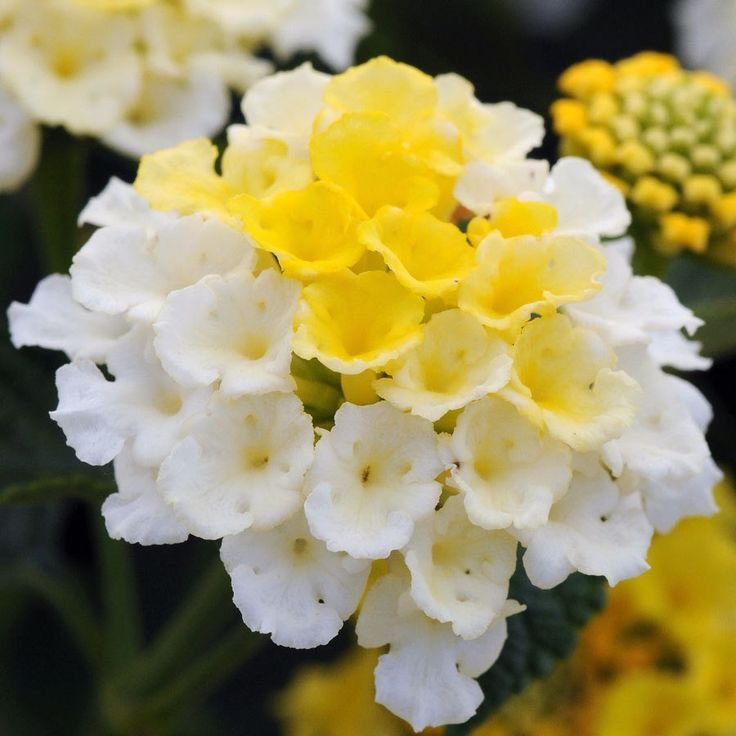
 It attract different kinds of birds and insects.
It attract different kinds of birds and insects.

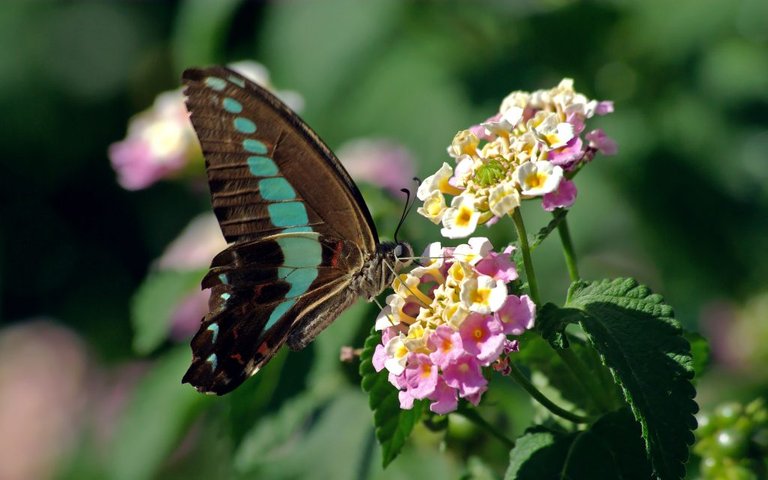
Lantana camara, often planted to embellish gardens, has spread from its native Central and South America to around 50 different countries.Lantana camara will often outcompete other more desirable species, leading to a reduction in biodiversity. It can also cause problems if it invades agricultural areas as a result of its toxicity to livestock as well as its ability to form dense thickets which if left unchecked can greatly reduce the productivity of farm land.
Toxicity:Lantana camara is known to be toxic to livestock such as cattle, sheep, horses, dogs and goats.
Biological:Insects and other biocontrol agents have been implemented with varying degrees of success in an attempt to control L. camara. It was the first weed ever subjected to biological control, however none of the programs have been successful despite 36 control agents being used across 33 regions.
Chemical:Using herbicides to manage L. camara is very effective but also expensive.
Uses:Lantana camara stalks have been used in the construction of furniture, such as chairs and tables; however, the main uses have historically been medicinal and ornamental.
Its a very useful plant.
That's what i thought you will like.Information found from-https://en.wikipedia.org/wiki/Lantana_camara
The growing and care of lantanas (Lantana camara) is easy. These verbena-like flowers have long since been admired for their extended bloom time.
There are several varieties available that offer a multitude of colors. Depending on the region and type grown, lantana plants can be treated as annuals or perennials. Grow lantana flowers in the garden or in containers. Trailing varieties can even be grown in hanging baskets. Lantanas also make a great choice for those wishing to attract butterflies and hummingbirds to the garden.
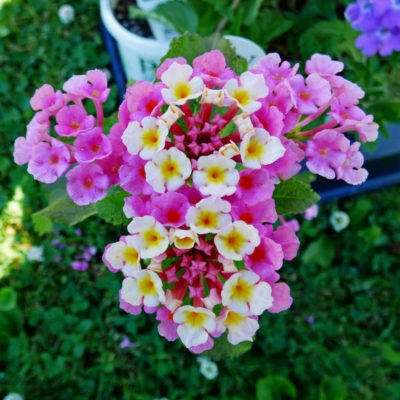
How to Grow Lantana Flowers ;
Growing lantana in the garden is a great way to add color and interest. Simply choose a sunny location and plant them in well-draining soil. Although these plants are tolerant of many soil conditions, lantana flowers prefer slightly acidic soil. Mulching with pine needles is an easy way to raise pH levels in areas with low acid. Lantanas are planted in spring once the threat of cold weather and frost have ceased. Keep in mind, however, that they prefer warm temperatures so new growth may be slow to appear. Once the temperatures warm up though, they will grow abundantly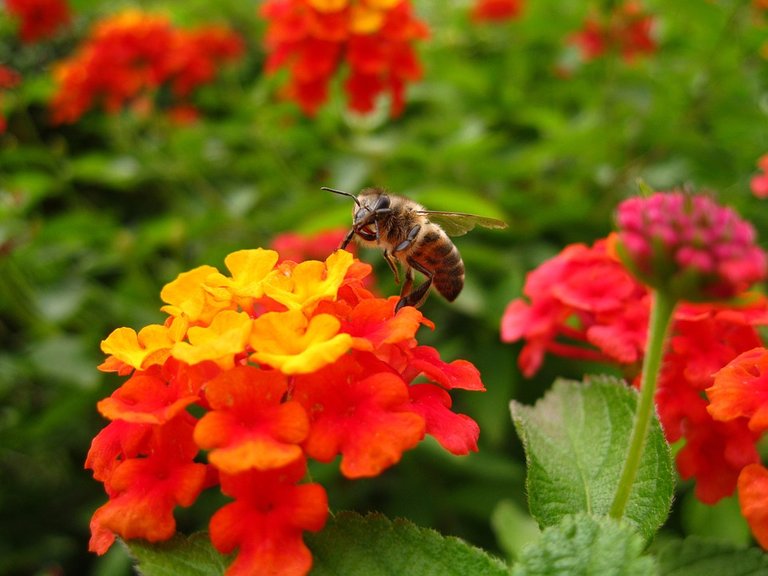
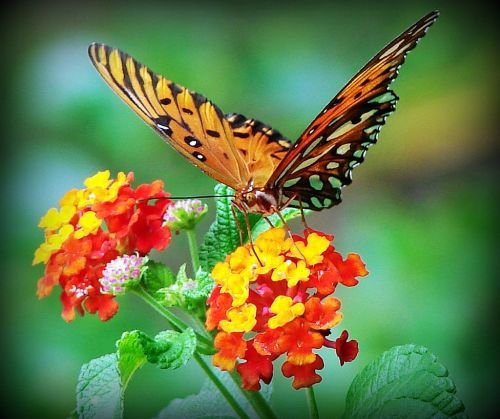
Lantana is a heavily branched shrub having bright green leaves, about 6cm long, with round toothed edges, grow opposite one another along stem.
Flowers vary in colour from pale cream to yellow, white, pink, orange, red, lilac and purple, about 2.5cm in diameter. Fruits are glossy, rounded, fleshy, purplish-black when ripe.
It grows in wide variety of habitats, from exposed dry hillsides to wet, heavily shaded gullies.
Native to tropical and subtropical regions of Central and South America, lantana is a heavily branched shrub that can grow as compact clumps, dense thickets, and scrambling and climbing vines. It can smother native vegetation and form impenetrable stands.
Lantana covers 5 million hectares throughout most coastal and hinterland areas of Australia, from north Queensland to southern New South Wales and including the Northern Territory and Western Australia. Lantana could also spread to Victoria. source
source
Lantana (Lantana camara) are variable species ranging from small compact garden specimens to larger weedy scrambling shrubs to 2m. The stems of the plant are square, often with prickles along the stem angle.
Flowers are grouped in clusters at the end of a stalk. These clusters are about 3cm across. Each individual flower is a tube with four spreading lobes. The colour forms include red, pink, white, yellow or orange flowers. The different colour forms vary in toxicity.
The leaves are opposite, with a serrated margin, 2.5–12cm long and 1.5–7cm wide, usually covered with stiff coarse hairs.
The fruit are small berries, 6–8mm long, green when immature, becoming glossy black when ripe.
Fatalities have been reported when berries were eaten. Symptoms are delayed several hours and may include vomiting, diarrhoea, laboured breathing, dilated pupils, lethargy and weakness. Respiratory irritation has been reported by workers clearing Lantana sites. Dermatitis can occur after contact with the leaves and stems.
Info Source
Pics Source
I hope you will like my efforts. Thank you @ctrl-alt-nwo for your precious time and valuable support.
Forest Lantana
I'm a woman who likes lantana flowers but is a little lazy to take care of her.
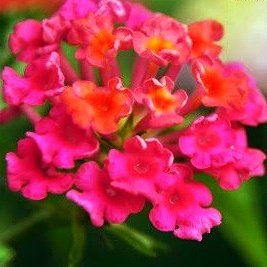
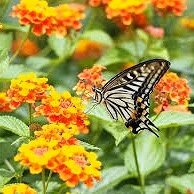
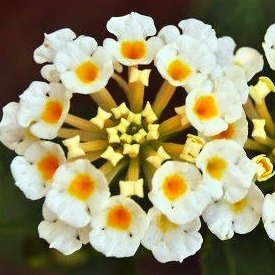
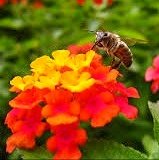
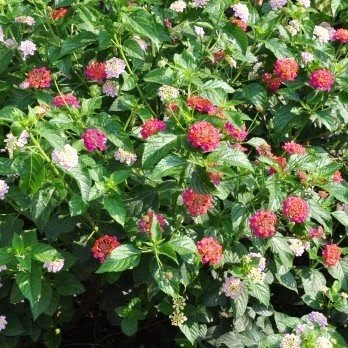
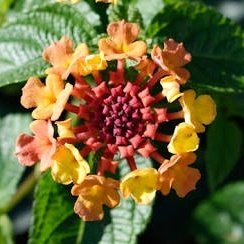
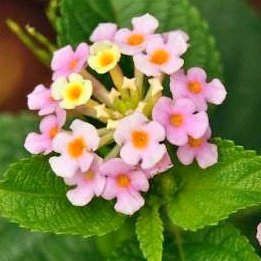
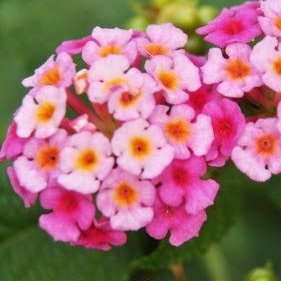
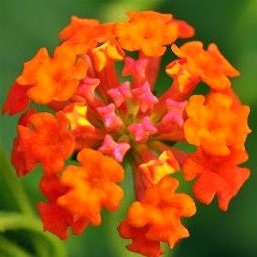
So far I have not found it too difficult to find a flowering but ineffective plant as I wanted.
One of my favorite flowers is the Lantana flower. Lantana is called a crop of a million sangking people easily find lantana. But clearly Lantana proved to be able to add vibrant gardens and gardens with an attractive interest. The colors of Lantana flowers are quite varied, from purple, yellow, white and red, there are also some types with a combination of white-yellow or white-magenta. Terms of growth is also easy, enough water and direct sun heat. Fertilization can be done once a month with NPK.
Originally Lantana comes from the mainland of America, then spread throughout the world to reach Indonesia. Do not know exactly when to get to Indonesia.
In Indonesia, Lantana is often called the flower because of the aroma of the leaves leu a langu and less savory if the hand touch. So, just look at it :) Lantana grows well in the highlands to the hot lowlands.
To my knowledge there are 2 types of plants Lantana, the first is Lantana that grows shrubs, while the second is Lantana that grows creeping.
Lantana bushes can grow up to 2 meters in height. Generally Lantana this type of shrub bush thorns, which although not very large thorns, but nyebelin also kalo until handed. Lantana type creep grows elongated but can not climb / propagate. Mostly used for cover crops. In addition it can also be used as a hanging plant, growing dangling ornaments with beautiful flowers.
Currently practically Lantana is a plant mainstay decorate my garden. While other plants are lying helplessly against the white lice attack, the Lantana remains gloriously free from the disruptive pests of that one.
But there are some things to watch out for from Lantana. Lantana can become a pest plant if its growth is not controlled. In addition to easy to grow alias minimal maintenance, Lantana bush is also fast growth.
One more thing, the fruit of the Lantana plant includes poisonous fruit. Young fruit plants lantana green color, which will change color to black after the old. The poison is found in young fruit, so do not eat it. :)
To multiply, Lantana can be grown from seed or from stem cuttings. Multiply from seed is usually more difficult and more time-consuming when compared with propagation by stem cuttings. Lantana sold in stalls of ornamental plants usually comes from propagation by stem cuttings.
Magoo-2 found a series of multi accounts of a same owner is following your articles to cheat your generous rewards.
Magoo-2 found these accounts are suspicious & can be multi accounts of a single owner. Conclusion is based on last 30 days transactions:
@seha76 @faisalrizal2018 @roman-sabil
magoo-2
Check our latest multi comment spam update report
@ctrl-alt-nwo, That's better description of Lantana. I've never seen before those plant or flowers. Thanks for information given. I add some extra information via web site.
Image by Yeonghason Lantana is a tough plant that thrives in bright sunlight, drought, and punishing heat. Don’t let the toughness fool you though, as lantana, available in a wide range of bright colors, is extremely beautiful and highly attractive to butterflies. This tropical plant is perennial for growing in USDA plant hardiness zones 8 and above, but is widely grown as an annual in cooler climates. It works well in borders and flower beds, and smaller varieties look great in containers. Lantana thrives without a lot of attention, and when it comes to fertilizing lantana plants, less is definitely more. Read on to learn about feeding lantana plants.
Feed in-ground lantana plants in early spring, using a dry fertilizer. Lantana isn’t picky but, in general, the best fertilizer for lantanas is a good quality, balanced fertilizer with a NPK ratio such as 10-10-10 or 20-20-20.
Lantana plant in containers need regular fertilization, as any nutrients in the potting mix are quickly depleted. Apply a slow-release fertilizer in spring, then supplement with a balanced, water-soluble fertilizer every two to four weeks.
Don’t overfertilize lantana. Although fertilizer may create a lush, green plant, the lantana is likely to be weak and will produce very few blooms. Always water deeply after fertilizing. Watering distributes fertilizer evenly around the roots and prevents scorching.
Image source: ggogle
Content source: https://www.gardeningknowhow.com/ornamental/flowers/lantana/fertilizing-lantana-plants.htm
Image by Gardening Know How, via Heather Rhoades Summer flowers are the song in the season’s heart. Lantanas are perfect examples of lively colored blooms that persist all season long. Over 150 species make up the family and there are many more types of lantana from which to choose due to heavy hybridization. One of the lantana varieties, Lantana camara, should be avoided in moist, warm regions where it can naturalize and become a pest plant. Most of varieties of lantana are annuals unless grown in the warmer regions of the continent.
Read more at Gardening Know How: Varieties Of Lantana: Learn About Lantana Plants For The Garden
Lantana, genus of more than 150 shrubs native to tropical America and Africa and belonging to the verbena family (Verbenaceae), order Lamiales. Common lantana (L. camara), growing to 3 metres (10 feet) tall, is a weed in tropical America, but elsewhere it is much used as a garden plant.
It blooms almost continuously with yellow, orange, pink, and white flower heads in various colour combinations. The aromatic leaves are rough and oval.
Trailing lantana (L. montevidensis), from South America, is a small-leaved, drooping, thinly branched species that bears rose-lavender flowers. Other species are variously known as yellow sage, weeping (or trailing) lantana, and polecat geranium.
Source is here
This is very beautiful garden and beautiful photography.
Have a great day.
My original photography in sri lanka ( Lantana Trees) thanks @ctrl-alt-nwo
I never see this plant before! But very similar type of flower I have seen in my country! Nice photography and useful information!@ctrl-alt-nwo,
Cheers~
Beach fronts.
Lantana camara is rarely found in natural or semi-natural areas of forest as it is unable to compete with taller trees due to its lack of tolerance for shade, and instead grows at the forest edge. Lantana camara can survive in a wide range of climatic conditions, including drought, different soil types, heat, humidity and salt. It is also relatively fire tolerant and can quickly establish itself in recently burnt areas of forest.
Lantana camara is considered to be a weed in large areas of the Paleotropics where it has established itself. In agricultural areas or secondary forests it can become the dominant understorey shrub, crowding out other native species and reducing biodiversity.The formation of dense thickets of L. camara can significantly slow down the regeneration of forests by preventing the growth of new trees.
Source
Lantana seed set varies considerably. If you see a lot of berries developing you may want to deadhead the plants to help with continuous blooming. If there is low berry set, deadheading shouldn't be necessary for continuous bloom. Some varieties are self-cleaning.
Lantana camara is a small perennial shrub which can grow to around 2 m tall and form dense thickets in a variety of environments. Due to extensive selective breeding throughout the 17th and 18th Centuries for use as an ornamental plant there are now many different L. camara cultivars...
Lantana camara is a highly variable ornamental shrub, native of the neotropics. It has been introduced to most of the tropics and subtropics as a hedge plant and has since been reported as extremely weedy and invasive in many countries....
Mature fruits of Lantana camara
Lantana is a gregarious, erect or half-climbing, somewhat hairy aromatic shrub; when erect, usually 1 to 2 meters high and when scandent, twice as high. Branches four-sided with recurved prickles. Leaves are elliptic, 5 to 9 centimeters long,3 inches long, pointed at the tip and rounded at the base and toothed in the margins. Flowers are pink, orange, yellow, white, lilac and other shades, according to the variety and borne in stalked heads which are 2 to 3.5 centimeters in diameter. Calyx small. Corolla-tube is slender; the limb spreading, 6 to 7 millimeters wide, and divided into unequal lobes. Stamens 4, in 2 pairs. Ovary is 2-celled, 2-ovuled. Fruit is drupaceous, sweet tasting, purple or black, fleshy ovoid, and about 5 millimeters long...
Lantana camara is rarely found in natural or semi-natural areas of forest as it is unable to compete with taller trees due to its lack of tolerance for shade, and instead grows at the forest edge. Lantana camara can survive in a wide range of climatic conditions, including
drought, different soil types, heat, humidity and salt. It is also relatively fire tolerant and can quickly establish itself in recently burnt areas of forest....
Some beautiful pictures of Lantana camara
Lantana camara or Wild sage or Cloth of gold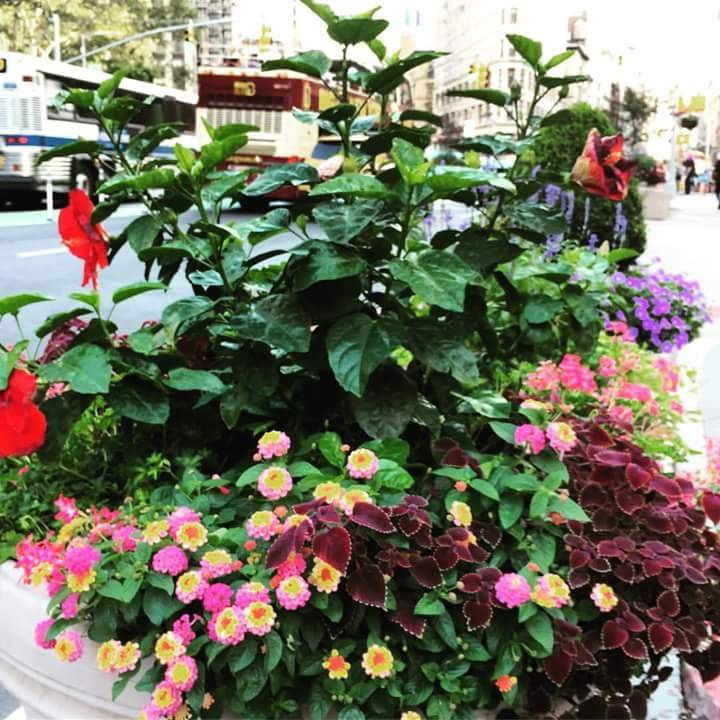
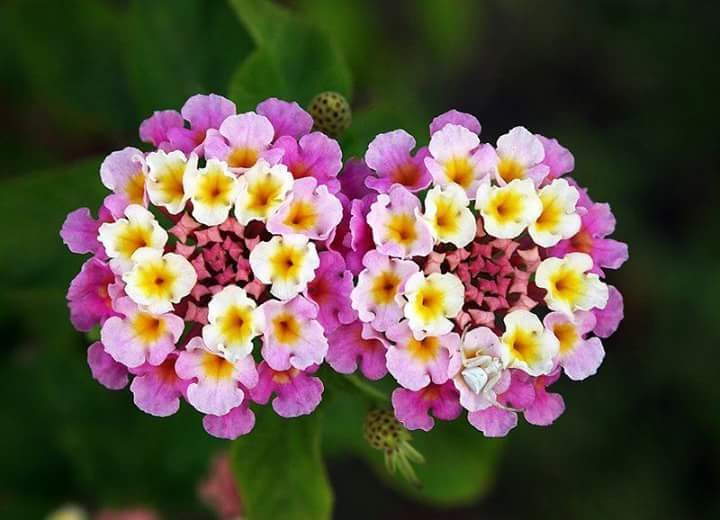 Lantana camara
Lantana camara
Lantana is Australia’s invasive weeds. Lantana is also highly toxic to humans & animals, and can cause serious illness and death. All parts of the plant, particularly the green berries, are poisonous if ingested, causing vomiting, diarrhoea, muscular weakness and respiratory distress. The plant is also a skin and eye irritant.
Beautiful but dangeous..
Lantana camara, commonly known as big-sage in Malaysia, wild-sage, red-sage, white-sage in the Caribbean islands; and tickberry in South Africa, is a species of flowering plant belonging to the Verbenaceae family.
The name Lantana derives from the Latin name of the wayfaring tree Viburnum lantana, the flowers of which closely resemble Lantana.
Lantana camara is native tropical regions in Central America and South America. However, it has naturalized in many parts of the world; mainly in the tropical and sub-tropical regions.
 This flowering plant with such beautiful flowers is however a notorious pest. The eradication of these plants is very difficult and costly too. Once the Lantana camara establishes itself in an ecosystem, it makes it unfit for other plants and the native flora are quickly exterminated, as they cannot survive the competition with Lantana camara.
This flowering plant with such beautiful flowers is however a notorious pest. The eradication of these plants is very difficult and costly too. Once the Lantana camara establishes itself in an ecosystem, it makes it unfit for other plants and the native flora are quickly exterminated, as they cannot survive the competition with Lantana camara. 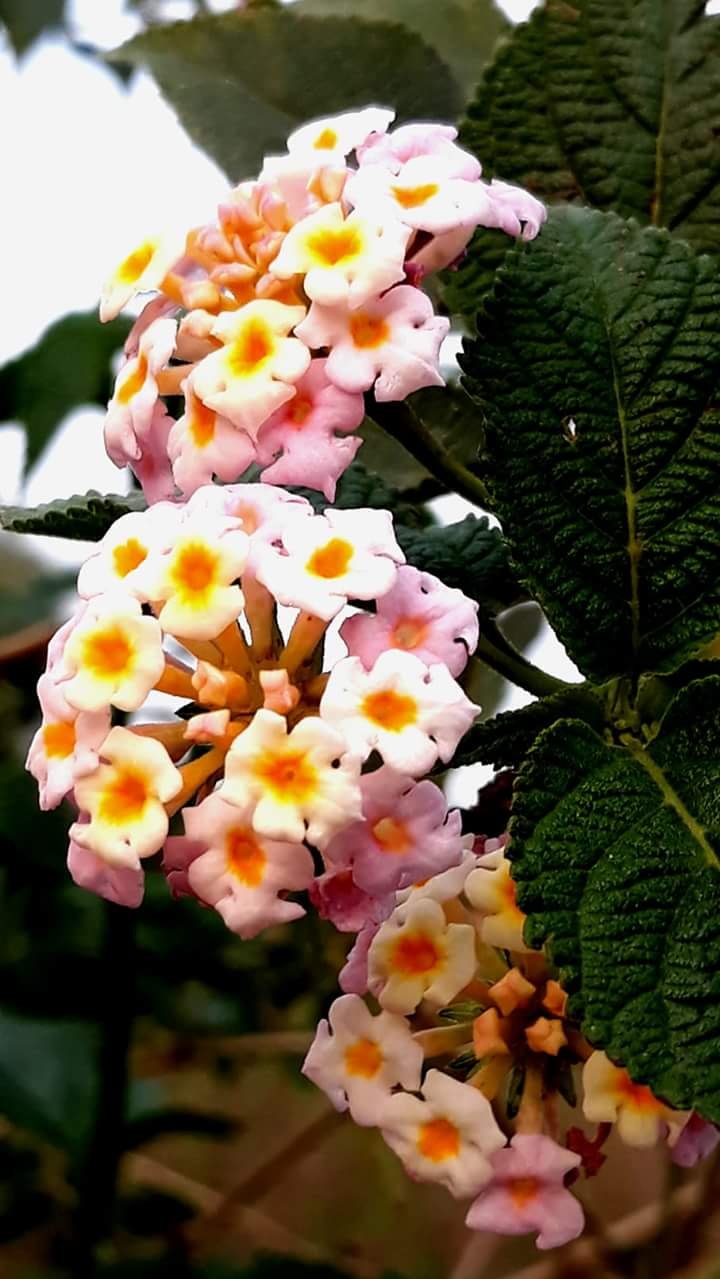 Lantana is a genus of about 150 species of perennial flowering plants in the verbena family, Verbenaceae. They are native to tropical regions of the Americas and Africa but exist as an introduced species in numerous areas, especially in the Australian-Pacific region. The genus includes both herbaceous plants and shrubs growing to 0.5–2 m (1.6–6.6 ft) tall. Their common names are shrub verbenas or lantanas. The generic name originated in Late Latin, where it refers to the unrelated Viburnum lantana.
Lantana is a genus of about 150 species of perennial flowering plants in the verbena family, Verbenaceae. They are native to tropical regions of the Americas and Africa but exist as an introduced species in numerous areas, especially in the Australian-Pacific region. The genus includes both herbaceous plants and shrubs growing to 0.5–2 m (1.6–6.6 ft) tall. Their common names are shrub verbenas or lantanas. The generic name originated in Late Latin, where it refers to the unrelated Viburnum lantana. 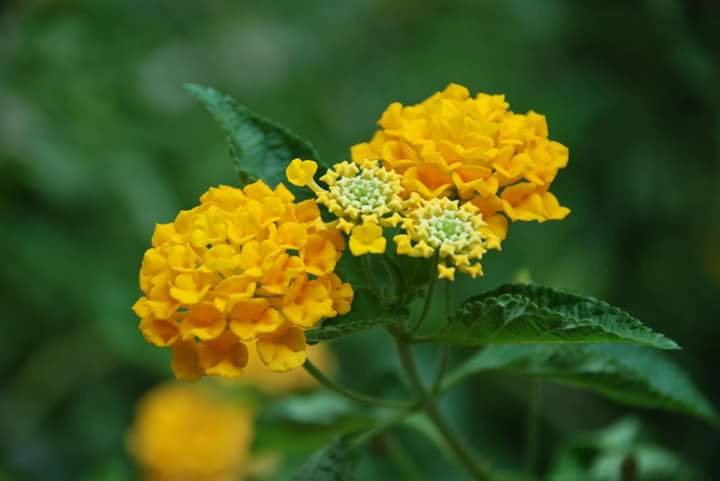 thanks to sharing for your good post again.my dear friend. @ctrl-alt-nwo
thanks to sharing for your good post again.my dear friend. @ctrl-alt-nwo
Lantana plants can be grown as evergreen perennials in USDA planting zone 8 and higher. These flowers are not native to Florida but have become naturalized there and are widespread. In fact, the shrubs are considered invasive plants there and in certain other warm regions. In more northerly zones, they are treated as annuals.
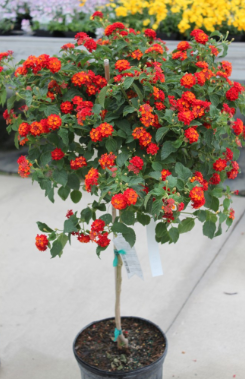
They are known for their rounded clusters of small, brightly-colored flowers. The flowers may be yellow, orange, white, red and purple, and often colors are mixed within the same cluster, creating a bicolored effect. Most people dislike the smell of the flowers. But the aroma of their foliage qualifies them as fragrant plants, in the view of some gardeners. The leaves smell, in fact, like citrus.
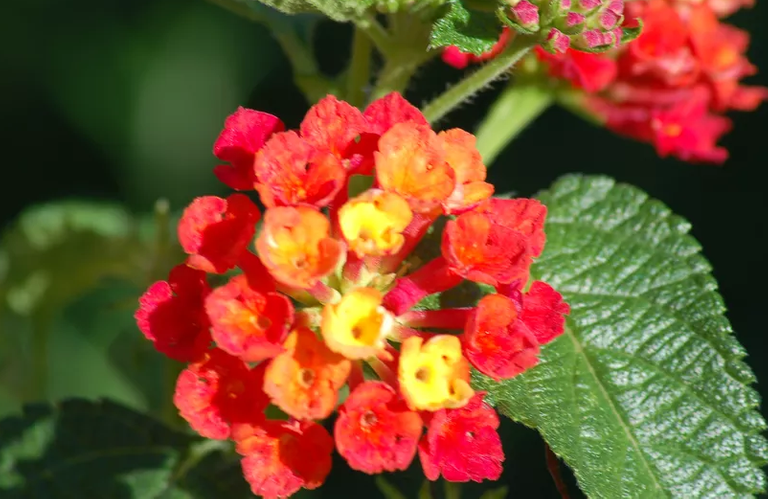
Lantana Bonsai – In Colorado
Lantana make really good Bonsai trees if you can find one with a big trunk. Finding one with a big trunk is hard to do outside of Florida. I do think it is possible to grow a small Lantana up if you can keep it alive over the winter. They do grow well under florescent lights in colder areas of the states. I keep mine directly under a large double t8 florescent light. I use an orchid fertilizer all winter, 1 scoop per gallon of water of this product: RePotMe Fertilizer. I have had the following Lantana since 2009 and have let the branches grow all winter long and pinch the flower buds off all winter long. In the spring the branches have been chopped back. After 7 years I feel the branches are big enough that I do not have to let it grow out any more and will keep it trimmed back this year. Lantana love to be re-potted. If your Lantana is wilting after watering, then you need to do an immediate re-potting session and cut back the branches. It should respond back with new growth.
Growing lantana in the garden is a great way to add color and interest. Simply choose a sunny location and plant them in well-draining soil. Although these plants are tolerant of many soil conditions, lantana flowers prefer slightly acidic soil. Mulching with pine needles is an easy way to raise pH levels in areas with low acid. Lantanas are planted in spring once the threat of cold weather and frost have ceased. Keep in mind, however, that they prefer warm temperatures so new growth may be slow to appear. Once the temperatures warm up though, they will grow abundantly.
Read more at Gardening Know How: How To Grow Lantana – Information On Growing Lantana
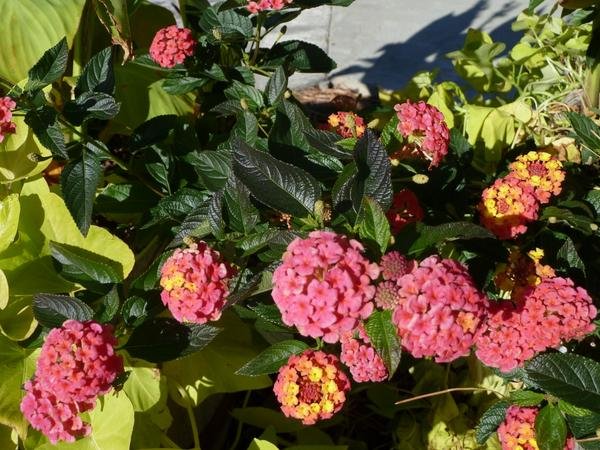
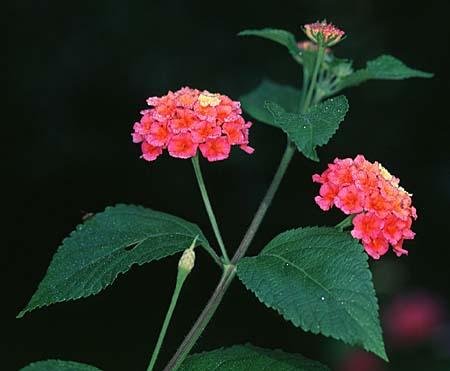
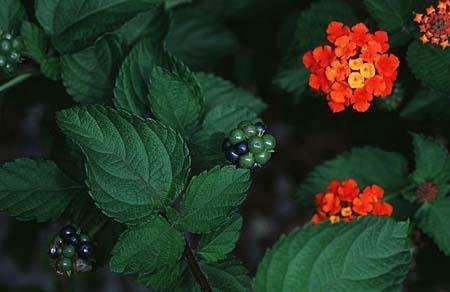
Common Name(s):
Common lantana, Lantana, Red sage, Yellow sage, shrub verbena
Cultivar(s):
Alba, Dallas Red, Miss Huff, New Gold
Description:
Small, perennial shrub with spiny, square stems; leaves simple, opposite or whorled, toothed, fragrant when crushed; flowers in flat-topped clusters on a long stalk, each flower small, tubular, 4-parted, white, pink, or yellow, changing to orange or red; fruit fleshy, green becoming bluish black. Lantana will perennialize in the warm coastal areas of N.C. The cultivar 'Miss Huff' will survive the winter in the Piedmont. Lantana is very attractive to butterflies and flowers from summer until frost.
Season:
Summer
Light:
Sun
Color:
White or Yellow turning orange, red or pink
Height:
1-5 ft.
Flower:
1 to 2 in. orange, yellow, or red and yellow flowers; fragrant; 0.3 in. berry-like drupe turns metallic blue or purple-black
How To Grow Lantana – Information On Growing Lantana

The growing and care of lantanas (Lantana camara) is easy. These verbena-like flowers have long since been admired for their extended bloom time. There are several varieties available that offer a multitude of colors. Depending on the region and type grown, lantana plants can be treated as annuals or perennials. Grow lantana flowers in the garden or in containers. Trailing varieties can even be grown in hanging baskets. Lantanas also make a great choice for those wishing to attract butterflies and hummingbirds to the garden.
How to Grow Lantana Flowers
Growing lantana in the garden is a great way to add color and interest. Simply choose a sunny location and plant them in well-draining soil. Although these plants are tolerant of many soil conditions, lantana flowers prefer slightly acidic soil. Mulching with pine needles is an easy way to raise pH levels in areas with low acid. Lantanas are planted in spring once the threat of cold weather and frost have ceased. Keep in mind, however, that they prefer warm temperatures so new growth may be slow to appear. Once the temperatures warm up though, they will grow abundantly.
Flowers is the beauty of nature. And Lantana Camara is also a beautiful flower. Lantana camara is a small tubular shaped flowers. It has many different colours like red, yellow, white, pink, orange and many more. It has also colonized area of Australia, Newzealand, Africa, Southern Europe, Middle East, India and the USA.
source
source
source
It has a medicinal value like it's leaves can display abtimocrobial and dungicinal. Also use as herval of cancer, skin itches, leprosy etc.
source
Lantana comes from the verbena family of plants. Lantana is an evergreen vining shrub. It is one of several plants that are recommended if you want a desert plant that lives well in a desert climate. It is perennial, meaning you will only need to plant it once. You can get pale yellow, bright yellow, orange, pink and purple varieties. The nice thing about using lantana is that it flowers pretty much all year long.
Some species of lantana are considered an invasive species. For instance, a common species, Lantana camara (also called Spanish flag) easily invades ecosystems and often forms in dense thickets. It can quickly dominate and suppress the growth of native plants, turning forest communities into shrublands.
It has become a serious economic pest in the citrus groves of Florida because it can reduce the crop yield.
Source: https://www.tripsavvy.com/lantana-an-easy-desert-plant-2681584
Lantana is a beautiful wild plant that evoke the memories of wild tropical field, it grows in almost all tropical and subtropical parts of South America, Africa, Australia, North America and South East Asia. In most of the tropical countries it is an invasive plant and considered as weed. Still, it is grown for its colorful flowers that release seductive fragrance, more intense in the evening. Fragrance of lantana depends on the variety you are growing, hybrid varieties are more fruity and mildly scented. Lantana flowers also attract bees, butterflies and nectar feeding birds.
Lantana Montevidensis is native to South America, and is characterized by white, purple or lavender colored scented flowers. If given support it can grow as a climbing vine and without support as groundcover.
It can be grown in pots with other upright growing plants on which it can climb or in hanging basket for dangling effect.
Source:- http://balconygardenweb.com/how-to-grow-lantana-care-and-growing-lantana/
Lantana is a beautiful, easy to grow garden plant. It’s tough, drought tolerant, long blooming, and attracts butterflies. Its lovely clusters of flowers come in a variety of colors, sometimes with multiple colors mixed together.
There are over 150 species of lantana, from trailing groundcovers to 6-foot tall shrubs. A cousin to verbena, lantana is native to the tropics, where it grows as a perennial or shrub.
Lantana foliage feels coarse and rough, with a pungent scent. Some varieties of lantana produce pretty (but poisonous!) purple berries while other sterile varieties skip the berries in favor of more blooms.
Details search from https://www.todayshomeowner.com/how-to-grow-lantana-in-your-garden.
@ctrl-alt-nwo
Wow fantastic garden . wonderful work. i like this Lantana trees and flowers
WOOD MINING (LANTANA)
They are leafless and always green. There are eye-catching flowers. There are more than 150 species of tree minerals spreading across Asia, Africa and America. Most of the year they are flowers. It is therefore a precious landscape material. These warm-loving plants remain green in places that are not frosted. In cold climates they become seasonal. It's fast-growing ones. It is a solution for such problematic places by covering to hot, stony and weak soil. It is used abundantly in my Southern region.

You can use it in flower baskets and as a dwarf fence. Tree Minerals are easy to maintain and require very little irrigation and fertilization. In spring and autumn, strong pruning provides a beautiful form and plenty of flowering. Although there are two most known and used species, they have many different flower colors and plant form hybrids. They are made of steel. After the pruning, put the remaining plants 10-15 cm in length into the appropriate peat-perlite mixture. Establish a regular irrigation period. Over time it will show rooting. Then surprise you when you want.
Magoo-2 found a series of multi accounts of a same owner is following your articles to cheat your generous rewards.
Magoo-2 found these accounts are suspicious & can be multi accounts of a single owner. Conclusion is based on last 30 days transactions:
@justdothat @harunbaki @justshowme @gifhy @lessismoring
magoo-2
Check our latest multi comment spam update report
Lantana one of popular plant @ctrt-alt-nwo.
Facts about the Lantana Flower
Lantana, or shrub verbena, grow as an evergreen or deciduous shrub. They do best in zones 9 and 10 or in Sunset's zones 12 & 13, and 15-22. You can find many colors of this flower now more than ever. From pale colors to the more bold colors. The intensity of the colors can change as the flower matures as well. You will find the colors red, orange, yellow, pinks and purples even now. They don't like frost, and will happily bloom until frost in many areas. In frost free areas, they can bloom all year if some care is taken.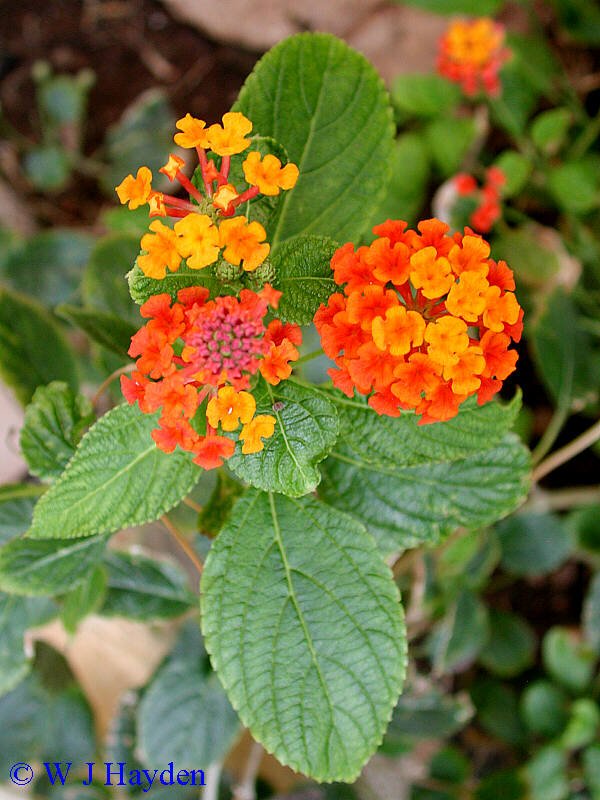
Lantanas like bright and full sun, and thrive in almost any kind of soil which is a real plus for poor gardening sites. You can skip waterings, but when you do water, you will want to do so thoroughly. They have been known to become invasive in some climates, but I honestly cannot picture it myself. If they grew more fully in my garden, then I would love that. They give off such beautiful little flowers that I just love them, as do the butterflies. Lantanas attract a wide range of butterflies.
There is a kind of lantana that is more of a trailing variety. The trailing variety is called L. montevidensis. They make a good ground cover with more rosy/lilac colored flowers. You can find many cultivars of both kinds of lantana. The colors of the reds and orange balance and compliment the rich green of the leaves. I would definitely recommend them for gardeners everywhere, even beginner gardeners love these.
One thing I have found to keep the blooms coming, it to occasionally trim back the plant. When flowers fade, I do a form of dead heading the flowers, so they will produce more.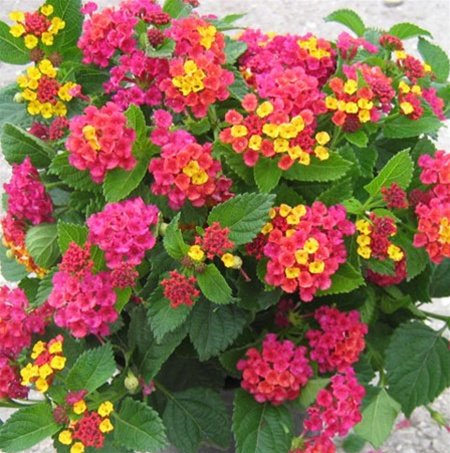
#source
Lantana is a Weed of National Significance. It is regarded as one of the worst weeds in Australia because of its invasiveness, potential for spread, and economic and environmental impacts.
Lantana is a serious threat to biodiversity in several World Heritage-listed areas including the Wet Tropics of northern Queensland, Fraser Island and the Greater Blue Mountains. Numerous plant and animal species of conservation significance are threatened. It is listed as the most significant environmental weed by the South-East Queensland Environmental Weeds Management Group.
There are two main forms of lantana in Australia: a cultivated form planted in gardens and a weedy variety found in bushland and pastures.Butterflies, bees and other insects are attracted by the nectar and pollinate lantana flowers. About half of the flowers produce seeds, typically 1–20 seeds on each flower head.
Lantana occurs naturally in Mexico, the Caribbean and tropical and subtropical Central and South America. It is considered a weed in nearly 50 countries.
Sources:
https://www.environment.gov.au/biodiversity/invasive/weeds/publications/guidelines/wons/pubs/l-camara.pdf
Lantana
I hear that butterflies adore these lovely Lantana flowers.But we also too with love on them.The planter also like them . It also seem have buyers market because I see a lot of product at online . below .
Lantana Camara that is also attractive with the wonderful color of pink, yellow and orange flowers . So beautiful in my sight .
I hear that flowers can grow in sunny location and these are tolerant many of soil condition. So , I think it will be grow in our location , Myanmar .That is great way to view color in my graden , haha.
It can be seem the last below photo , It is like a ball flowers. That is so beautiful shape . Thank all of you . good luck.
source
Plant taxonomy classifies lantana plants as Lantana camara. Various cultivars are sold, including the 'Spreading Sunset' cultivar, which has a flower head with gold centers surrounded by orange. This orange color later fades to pink.
Lantana plants are evergreens of the broadleaf variety. Although they may act a little like vines, they are classified by botanists as, technically, shrubs. But because of the vine-like appearance of their branches, they are often grown in hanging pots, in which their branches are allowed to spill over the sides.

USDA Plant Hardiness Zones, Plant Characteristics, Growing Tips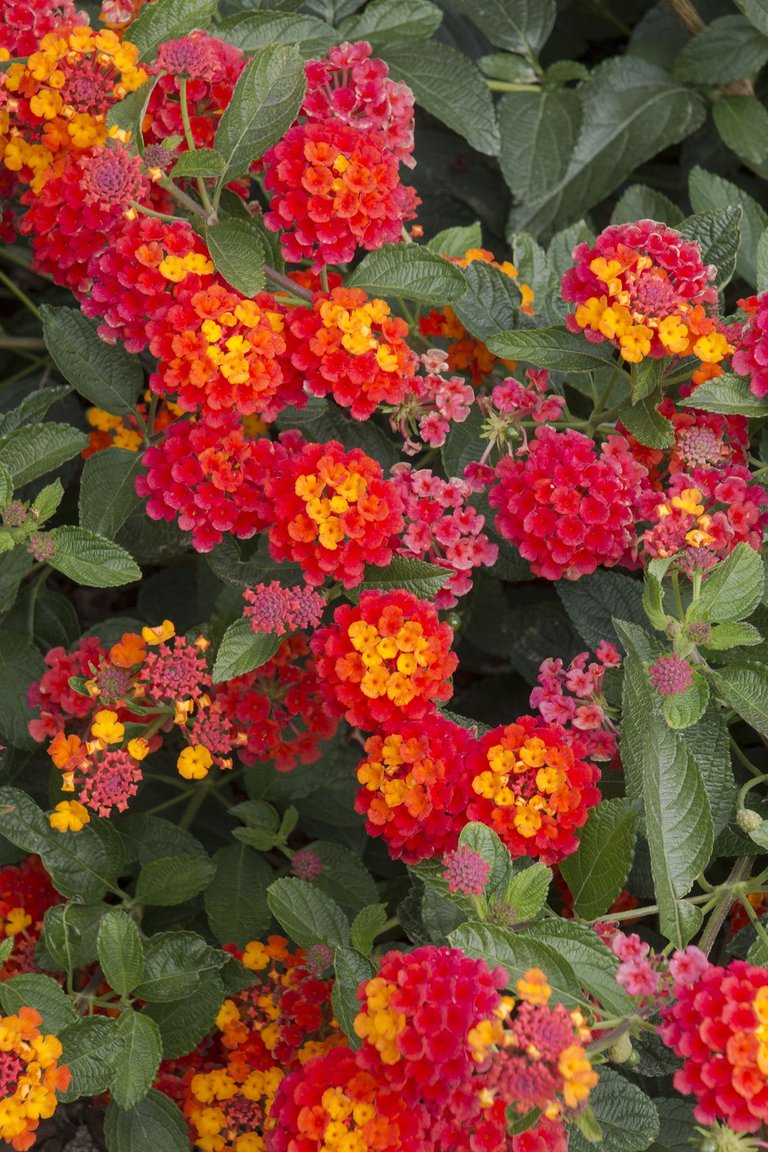
Lantana plants can be grown as evergreen perennials in USDA planting zone 8 and higher. These flowers are not native to Florida but have become naturalized there and are widespread. In fact, the shrubs are considered invasive plants there and in certain other warm regions. In more northerly zones, they are treated as annuals.
They are known for their rounded clusters of small, brightly-colored flowers. The flowers may be yellow, orange, white, red and purple, and often colors are mixed within the same cluster, creating a bicolored effect. Most people dislike the smell of the flowers. But the aroma of their foliage qualifies them as fragrant plants, in the view of some gardeners. The leaves smell, in fact, like citrus.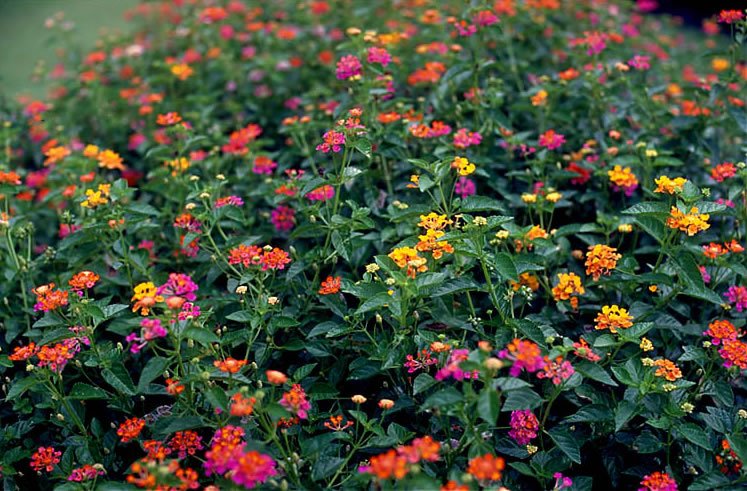
Lantana plants can reach 6 feet high (with a spread of 8 feet) in a Florida landscape. They are salt-tolerant, making them popular in beach communities.
They are also drought-tolerant once mature. Grow lantana in full sun. These flowers want well-drained ground but will tolerate poor soils.
They are sometimes called "verbena bushes", although nurseries selling them in hanging baskets do make a distinction between lantana plants and verbena (the latter also being a popular plant for hanging pots
@source
If you transfer money to your friend or sister or brother account,what does that account mean to you??
It a spam id .
Many of same family ( brother,cousin,sister,friend) can use steemit and they can transfer money one another if needed.that does not mean that all accounts are one.@ctrl-alt-nwo sir, I don't know why you support @magoo-2 ? @greenman sir last post flagged him all comment.
Yes, maybe your use of multiple accounts is legitimate as you say. But how many people are using multiple accounts to cheat ?? How do i know the difference between those who are legitimate, and those who cheat ??
But I do not know any other account and have never transaction with me. So how does he tell me? All the accounts of one???Three months ago my cousin @purepinag transferred sbd to me.because she did not had any bittrex or blocktrades account.
ha ha ha you are a cheat @sumonsha, you have 11 multi accounts
You lie and fake id. You tried to fool people by making a lie.you are a cheat.
My name is David and this is my won account.
Each of the IDs I've got has more than
one account. You can check their wallet. @ctrl-alt-nwo
magoo-2 found a series of multi accounts of a same owner is following your articles to cheat your generous rewards.
magoo-2 found these accounts are suspicious & can be multi accounts of a single owner. Conclusion is based on last 30 days transactions:
@rik432 @ratul8940 @rahul72 @taylor10 @villani @wilson6 @masud90 @purepinag @sumonsha @perry1 @max1994
magoo-2
Check our latest multi comment spam update report
Lantana camara is a small perennial shrub which can grow to around 2 m tall and form dense thickets in a variety of environments.Due to extensive selective breeding throughout the 17th and 18th Centuries for use as an ornamental plant there are now many different L. camara cultivars.Another smart work by @ctrl-alt-nwo sir...
Lantana camara has small tubular shaped flowers which each have four petals and are arranged in clusters in terminal areas stems. Flowers come in many different colours including red, yellow, white, pink and orange which differ depending on location in inflorescences, age, and maturity.After pollination occurs the colour of the flowers change (typically from yellow to orangish, pinkish, or reddish), this is believed to be a signal to pollinators that the pre-change colour contains a reward as well as being sexually viable, thus increasing pollination efficiency.
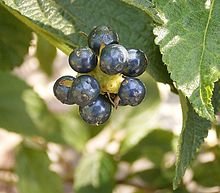
The leaves are broadly ovate, opposite, and simple and have a strong odour when crushed.
Wel done sir....
L. camara is a highly variable ornamental shrub, native of the neotropics. It has been introduced to most of the tropics and subtropics as a hedge plant and has since been reported as extremely weedy and invasive in many countries. It is generally deleterious to biodiversity and has been reported as an agricultural weed resulting in large economic losses in a number of countries. In addition to this, it increases the risk of fire, is poisonous to livestock and is a host for numerous pests and diseases. L. camara is difficult to control. In Australia, India and South Africa aggressive measures to eradicate L. camara over the last two centuries have been largely unsuccessful, and the invasion trajectory has continued upwards despite control measures. This species has been the target of biological control programmes for over a century, with successful control only being reported in a few instances.
.jpeg)
Wel done and perfect work sir...
Caring for Lantana Plants
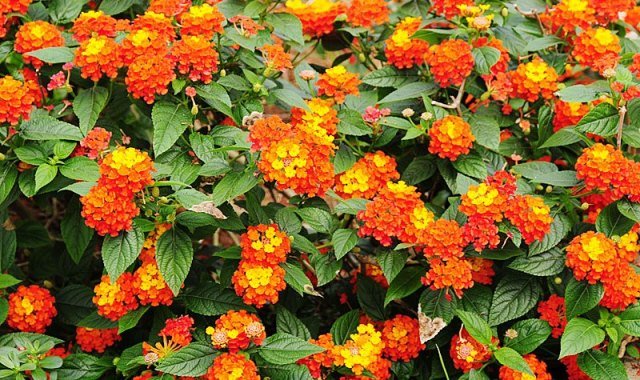
Bring a Little Piece of Florida to Your Own Landscaping
USDA Plant Hardiness Zones, Plant Characteristics, Growing Tips
Lantana plants can be grown as evergreen perennials in USDA planting zone 8 and higher. These flowers are not native to Florida but have become naturalized there and are widespread. In fact, the shrubs are considered invasive plants there and in certain other warm regions. In more northerly zones, they are treated as annuals.

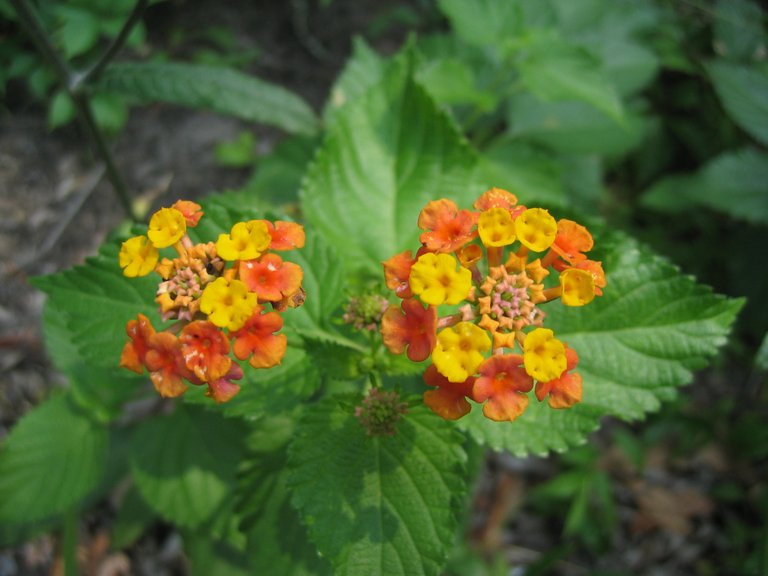
They are known for their rounded clusters of small, brightly-colored flowers. The flowers may be yellow, orange, white, red and purple, and often colors are mixed within the same cluster, creating a bicolored effect. Most people dislike the smell of the flowers. But the aroma of their foliage qualifies them as fragrant plants, in the view of some gardeners. The leaves smell, in fact, like citrus.
Lantana plants can reach 6 feet high (with a spread of 8 feet) in a Florida landscape. They are salt-tolerant, making them popular in beach communities.
They are also drought-tolerant once mature. Grow lantana in full sun. These flowers want well-drained ground but will tolerate poor soils.

They are sometimes called "verbena bushes", although nurseries selling them in hanging baskets do make a distinction between lantana plants and verbena (the latter also being a popular plant for hanging pots).
Evergreen perennials in hot regions, they are more often grown just for the summer months in colder climates. The purple variety (L. montevidensis) is even more vine-like than the rest, and, consequently, it is a better hanging plant.
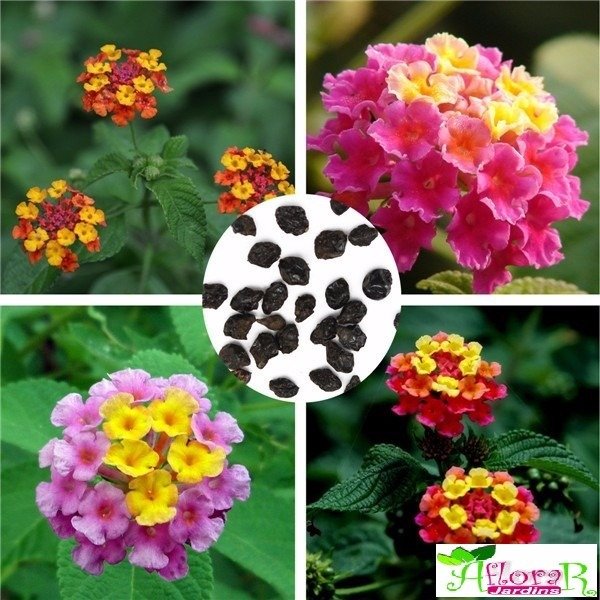
Northerners sometimes wonder if they can be taken indoors in fall and overwintered as houseplants. The answer is yes and no. Yes, they can be overwintered inside, but they do not thrive as houseplants. It is better to place them in an unheated room for the winter and keep them in a dormant state, providing just minimal light and water. The temperature of the room should not dip much below 50 degrees Fahrenheit.
magoo-2 found a series of multi accounts of a same owner is following your articles to cheat your generous rewards.
magoo-2 found these accounts are suspicious & can be multi accounts of a single owner. Conclusion is based on last 30 days transactions:
@moniristi @shishiristi
magoo-2
Check our latest multi comment spam update report
Caring for Lantana Plants While newly planted lantanas require frequent watering, once established, these plants require little maintenance and are even tolerant of somewhat dry conditions. In fact, a good soaking about once a week should keep them relatively happy. Although it isn’t required, lantana plants can be given a light dose of fertilizer each spring, but too much may inhibit their overall flowering. To encourage reblooming, cut the tips (deadhead) periodically.

Overgrown plants can be given new life by cutting back a third of their growth. They will bounce back quickly. Regular pruning of the plant usually takes place in spring.
Common Problems with Growing Lantanas While lantanas are not affected by too many problems, you may encounter them on occasion. Powdery mildew can become a problem if the plant is not given enough light. In addition, the plant may develop root rot if it is kept too wet. Sooty mold is a condition that causes black discoloration on the leaves and is most often attributed to insect pests, such as whiteflies. Other common pests that affect lantana plants include lace bugs, which cause the foliage to turn gray or brown and then drop off.
Lantana is a genus of about 150 species of perennial flowering plants in the verbena family, Verbenaceae. They are native to tropical regions of the Americas and Africa but exist as an introduced species in numerous areas, especially in the Australian-Pacific region. The genus includes both herbaceous plants and shrubs growing to 0.5–2 m (1.6–6.6 ft) tall. Their common names are shrub verbenas or lantanas. The generic name originated in Late Latin, where it refers to the unrelated Viburnum lantana.
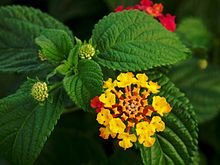
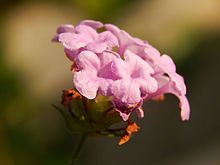
Lantana's aromatic flower clusters called umbels are a mix of red, orange, yellow, or blue and white florets. Other colors exist as new varieties are being selected. The flowers typically change color as they mature, resulting in inflorescences that are two- or three-colored.
"Wild lantanas" are plants of the unrelated genus Abronia, usually called "sand-verbenas".
This is a very beautiful plant.It look's nice in the garden.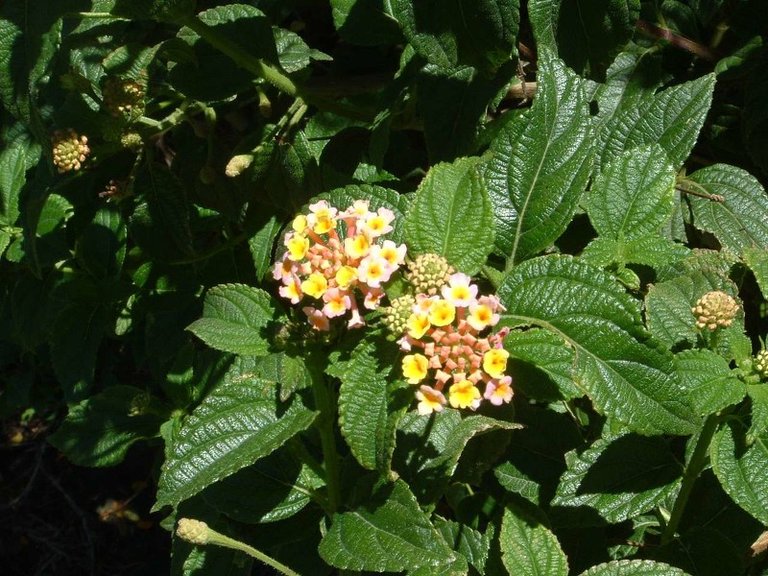
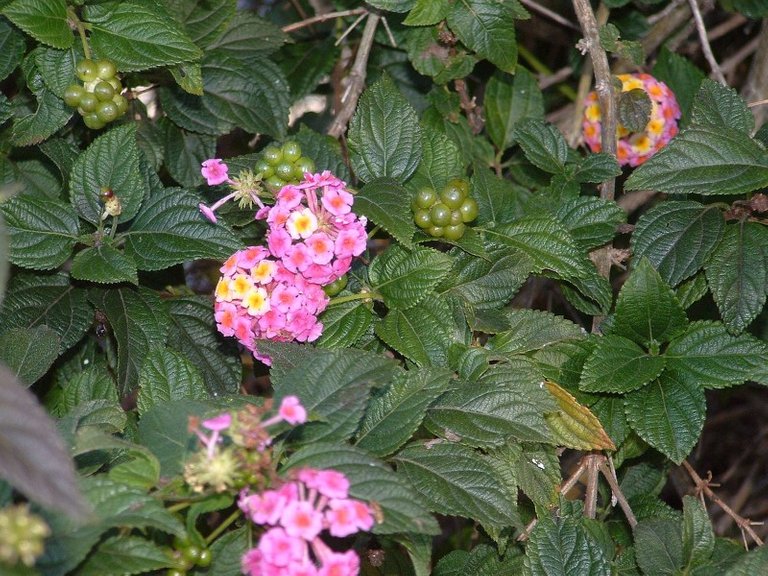
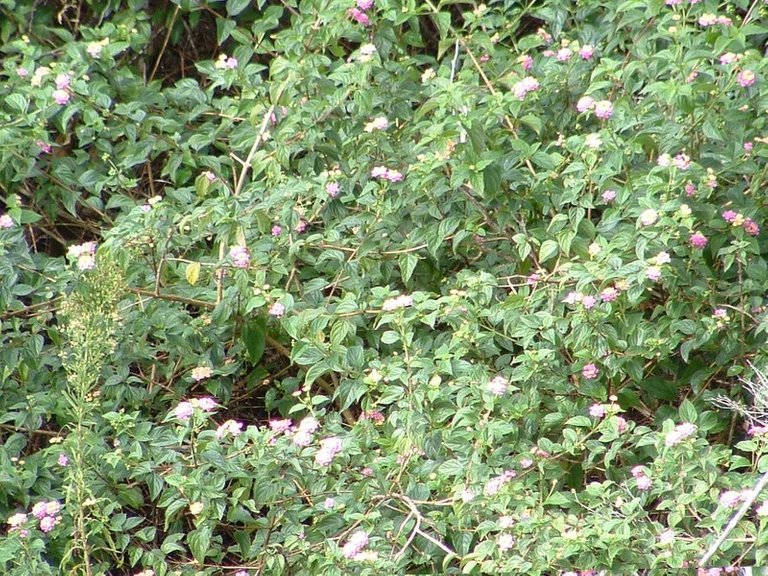

Botanical Name of the plant is Lantana camara var. aculeata.This plant also known as Lantana scabrida, Camara vulgaris, wild sage, red-flowered sage, and largeleaf lantana are similar.
It is from tropical America.It looks like Smelly scrambling evergreen shrub to 4-5 m with woody taproot with laterals that sucker when broken. Young stems are 4-angled, hairy and prickly, and older stems are rounded, woody, much branched, and brittle. Hairy, ovalish leaves (3-9 cm long) in opposite pairs along the stems, very wrinkled, and have toothed edges.
There are some similar species: Other L. camara cultivars and crosses. Lantana montevidensis is low growing or prostrate, has smaller leaves and purple or white flowers, and is occasionally weedy.
What damage does it do?:Totally smothers and replaces all other species on the ground, causing permanent loss of habitat.
What can you do to get rid of it?:Remove small infestations first.
Spray (best in November-December): glyphosate (100ml/10L + penetrant) or Tordon Gold (10ml/L).Cut down and paint stump (all year round): glyphosate (200ml/L).
Don't replant for two years after all plants destroyed.Seed longevity usually low. Replant with dense cover and constantly check for new seedlings. That's all from me.
Information source-http://www.weedbusters.org.nz/weed-information/lantana-camara-var-aculeata/59/
magoo-2 found a series of multi accounts of a same owner is following your articles to cheat your generous rewards.
magoo-2 found these accounts are suspicious & can be multi accounts of a single owner. Conclusion is based on last 30 days transactions:
@rupok @sarahmcdowell2 @razu788
magoo-2
Check our latest multi comment spam update report